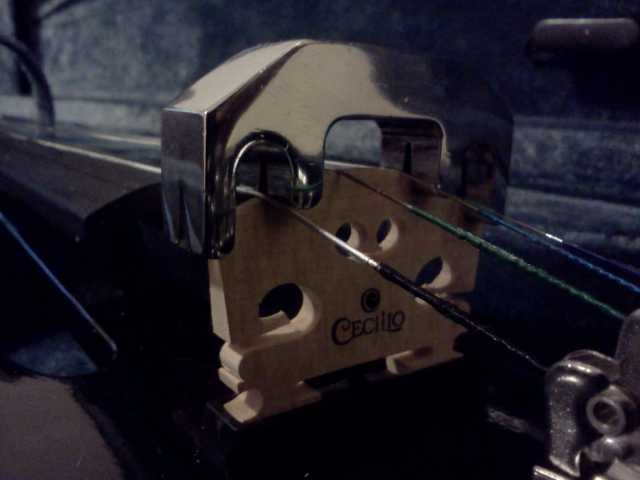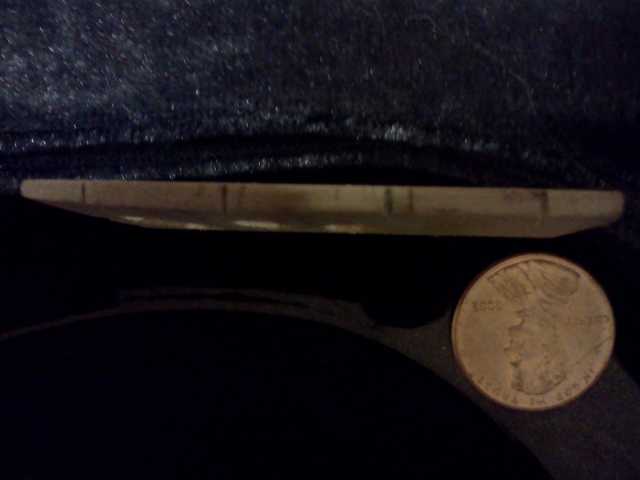Welcome to our forum. A Message To Our New and Prospective Members . Check out our Forum Rules. Lets keep this forum an enjoyable place to visit.
Currently working on errors from the latest (SimplePress) forum update. Many issues have been resoled and others are being worked on. Thank you for your patience.
 Topic RSS
Topic RSS



 (2 votes)
(2 votes) Member
 Offline
Offline


 Purchased cecilio violin and also brass mute here
Purchased cecilio violin and also brass mute here
qid=1346111605&sr=8-5&keywords=violin+mute
The rubber mute i already had provides nice tight fit, but metal one barely goes on as
visible in the attached image. My question is do I have a bridge that is too wide
or is it the mute that is not made to correct standards?
It appears that the bridge is too thick and need's to be sanded to spec's. I've never used a mute, rubber or otherwise and certainly no authority, but if you look at the slot in the mute where it slide's down over the bridge, it has a ways to go yet. Just looking at the top of the bridge, it look's awfull thick. Should you sand it yourself, sand from the front side keeping the bridge slightly tapered. I've never had to refit a bridge as far as thickness. ![]() It also appear's that the bridge may be a little wide, the mute shouldn't touch the string's when it slides down on the bridge. You may have to relocate the string placement for propper spacing.
It also appear's that the bridge may be a little wide, the mute shouldn't touch the string's when it slides down on the bridge. You may have to relocate the string placement for propper spacing.
I'm sure some of the other member's can help you also.
Regulars
 Offline
Offline
pgb205 said
My question is do I have a bridge that is too wide
or is it the mute that is not made to correct standards?
This might be useful:
Fitting a Bridge to a Professional Quality Instrument
Regulars
 Offline
Offline
FM: I inherited an old fiddle, which is how I happened to take up fiddle. I had to set the sound post and string it and make a bridge. Above is one of the documents that I worked from. The fiddle in question was decidedly not professional quality, so it may have been a misapplication to make the bridge as thin as I did (4.4 mm at the foot, about 1.4 mm at the top) and to make the feet as thin as I did (1.4 mm). It required a lot of sandpaper and elbow grease. But the fingerboard is low, so getting the right string action implied that the bridge would be short and that the string angle was not going to give a lot of power. So maybe it was a good idea to reduce the thickness.
I also bought an MV400. The bridge was fairly warped when it arrived, so I used the spare, which is also starting to warp. Both of those bridges were thick, but I think they were just prone to warp. I will probably make a new bridge for my MV400, but that fiddle weighs a hundred grams more than my old one, so I won't bother making the new bridge so thin.
Regulars
 Offline
Offline
cdennyb said
I did a nice pdf for making a backup bridge complete with pictures if you're interested in looking at it. It's located here:
Great instructions, and that is a great photo with labels on the parts of the bridge. If it belongs to you, how about contributing it to the Wikipedia article on bridges: http://en.wikipedia.org/wiki/B.....trument%29
Regulars
 Offline
Offline
Fiddlerman said
I have no idea if it was a misapplication of any sort but you should be proud to have done it. Not many beginners attempt such things. As a matter of fact, pros don't either. Good for you.My bridge is fairly thin as well.
<photos snipped>
The guy who made this bridge is the same one who made my violin. His name is Jan Larsson and lives in Lima, Sweden.
This bridge is over 15 years old and hasn't warped a bit. Super hard maple.
Good photos. Wow, those are some thin feet on your bridge. Under a millimeter, I bet.
Oh, I also had to fit a new endpin when the old one snapped.
Certainly my luthier work hasn't been as good as a pro could do. But I am able to do the basic common things to keep a fiddle up and playable. I like to think the result is 80% of what a pro would deliver (if that kind of thing is even measurable) at 10% of the money cost. Having a pro do it would cost more than the fiddles are worth. I don't even know whether anybody within 50 miles does any violin work, as I am in the biggest city in that radius, and I don't believe there is a high-school orchestra in that radius. I believe that if I were to take a fiddle in to the local music store in my city (25,000 souls) they would send it in to their luthier in their central location (60 to 100 miles away) to have the work done.
Regulars
 Offline
Offline
Regulars
 Offline
Offline
Regulars
 Offline
Offline
cdennyb said
Dennis, I just realized that you made that PDF. It's great, thanks a lot. You wouldn't be interested in making a "how to fit new pegs" PDF would you?
I can certainly do that Pierre. But in the cold harsh reality of it... I seriously doubt if anyone on here that doesn't have an interest in accumulating luthier tools would justify the one time use of a peg shaper ($73.50) and a hole reamer ($53.98 semi-fluted to be proper).
I have them because I worked PT at the shop and on ocassion will do some for others during a setup or repair to an instrument.
That is actually a job needed by one of my fiddles. You're right that the cost of the tools has been holding me back. But also I don't think I could find good instructions last time I looked into it.
Somebody could do-it-themselves and sell the tools when they are done. Here is a reamer for $36 delivered. http://www.ebay.com/itm/VIOLIN.....0d05f3 And here is a peg shaper together with a reamer for $78 delivered. http://www.ebay.com/itm/Luthie.....689e1dd0 Please say whether you think these look adequate.
What about writing a quick overview of fitting pegs, say a half or a quarter of a page, even without photos? Then if you find interest in it, you could fill in the details later.
BTW, I've sometimes wondered whether anybody sells preshaped pegs. Seems like you could just specify them by the diameter of the end---they would all have the same length and taper. Then somebody would just need a reamer to fit their own pegs. The reamer could be used as a gauge for each hole, to know what end-diameter peg to order. There would be say ten or twenty different end-diameters, and a factory could turn out each size, perfectly shaped, by the hundreds.
Great job Dennis.
I want to add about bushing the peg holes. Far too often there will be cracks at the peg holes or they are just too worn. To remedy this you use a maple dowel and shave it too a very fat peg. Ream the peg holes and glue these over-sized pegs into the peg holes. When dry trim them flat with the sides of the peg box. Then from each side drill a pilot hole through the bushing. Now from the side the peg goes into drill through both bushing pieces and now ream out to fit a new peg.
1 Guest(s)


 Log In
Log In Register
Register

































